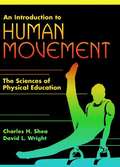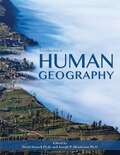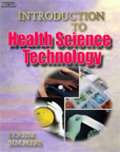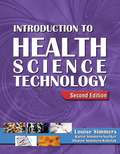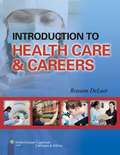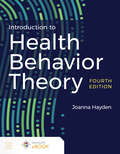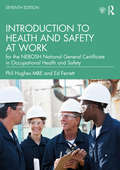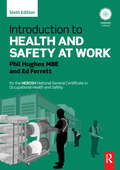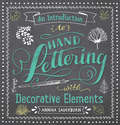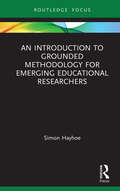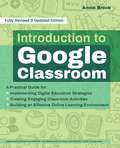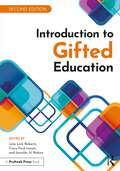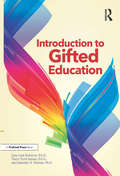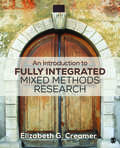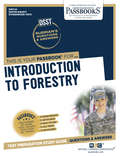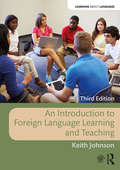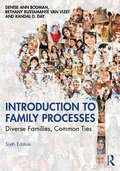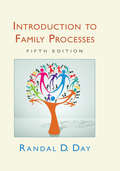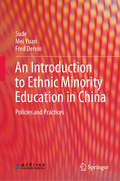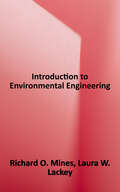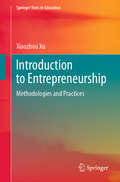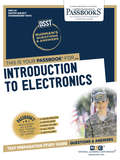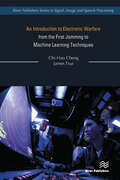- Table View
- List View
An Introduction to Human Movement
by Charles H. Shea David L. WrightThis new book is designed for the newly developing curriculum emerging in the field of Physical Education Exercise Science. Today, there is a renewed interest and dedication to the scientific study of human movement. This is reflected in the trend for physical education programs to change their names to departments of Kinesiology, Exercise and Sport Sciences, Human Movement, etc. This book captures this shift in the field of physical education by covering each of the sub-disciplines related to the study of human movement at an introductory level. For professionals in the field of physical education.
Introduction to Human Geography
by David Dorrell Joseph P. HendersonGeography is a diverse discipline that has some sort of connection to most every other academic discipline. This connection is the spatial perspective, which essentially means if a phenomenon can be mapped, it has some kind of relationship to geography. Studying the entire world is a fascinating subject, and geographical knowledge is fundamental to a competent understanding of our world. You will learn what geography is as well as some of the fundamental concepts that underpin the discipline. These fundamental terms and concepts will be interwoven throughout the text, so a sound understanding of these topics is critical as you delve deeper into the chapters that follow. By the end of the first chapter itself, you will begin to think like a geographer.
Introduction To Health Science Technology
by Louise SimmersIntroduction to Health Science Technology covers the core information needed to pursue a career in health care from an introduction of the health care industry and the basics of a health care system to overview of health care careers and legal and ethical responsibilities of health care workers to medical terminology and basic anatomy and physiology.
Introduction to Health Science Technology
by Louise Simmers Karen Simmers-Nartker Sharon Simmers-KobelakThis text overviews the health care field for beginning students in health sciences or health occupations, covering standard precautions, cultural diversity, medical math, teamwork and leadership, and computer technology. Learning features include chapter objectives and summaries, Internet exercises, and review questions, plus step-by-step directions of basic procedures in the field illustrated with color photos. A separate workbook and CD-ROM are available. Simmers is a member of the University of Maryland Nursing Alumni Association. Annotation (c)2003 Book News, Inc. , Portland, OR (booknews. com)
Introduction to Health Care and Careers
by Roxann Delaet<p><i>Introduction to Health Care and Careers</i> provides students beginning their health care education with the fundamentals they need to develop their personal and professional skills, understand their chosen profession, and succeed in the world of health care. It meets the growing market demand for a book that gives the best of both worlds—skill development and career choice information. The text begins with today’s health care system, health care economics, and law and ethics, providing important context for the personal, professional, and workplace skills that follow. From there, students move on to an overview of careers in health care and detailed profiles of the most in-demand professions. The book closes with brief chapters on anatomy and physiology to prepare students for the rest of their health care education. <p>With its student friendly approach,<i>Introduction to Health Care and Careers</i> is the essential resource for introductory health care courses, striking the perfect balance between skill development and up-to-date career choice information–everything health care students need to succeed.</p>
Introduction to Health Behavior Theory
by Joanna HaydenDesigned to provide students with an easy to understand, interesting, and engaging introduction to the theoretical basis of health education, Introduction to Health Behavior Theory, Fourth Edition uses comprehensive and accessible explanations to help students understand what theory is, how theories are developed, and what factors influence health behavior theory. Covering the more commonly used health behavior theories in individual chapters, the author breaks each theory into concepts and constructs to enhance comprehension and encourage students to discover how these theories can be put into practice.
Introduction to Health and Safety at Work: for the NEBOSH National General Certificate in Occupational Health and Safety
by Ed Ferrett Phil Hughes MBEIntroduction to Health and Safety at Work covers the fundamentals of occupational safety and health for the thousands of students who complete the NEBOSH National General Certificate in Occupational Health and Safety each year. This seventh edition closely follows the NEBOSH National General Certificate syllabus which was updated in 2019 and comes into use in 2020. The highly illustrated content covers all of the essential elements of health and safety management, the legal framework, risk assessment and control standards and also includes checklists, report forms and record sheets to supplement learning. It also has an extensive summary of current health and safety legislation. • Aligned to the NEBOSH National General Certificate in Occupational Health and Safety • Practice questions and answers to test knowledge and increase understanding • Complete with a companion website containing extra resources for tutors and students The book is suitable for all students following a level 3 Health and Safety course and a source of reference and guidance for managers at work in the UK. Written by renowned authors, this book is often provided as part of the Certificate course and is essential reading for a student.
Introduction to Health and Safety at Work: for the NEBOSH National General Certificate in Occupational Health and Safety
by Phil Hughes Ed FerrettIntroduction to Health and Safety at Work covers the fundamentals of occupational safety and health for the thousands of students who complete the NEBOSH National General Certificate in Occupational Health and Safety each year. Fully revised in alignment with the April 2015 syllabus, this sixth edition provides students with all they need to tackle the course with confidence. The highly illustrated content covers all of the essential elements of health and safety management, the legal framework, risk assessment and control standards and also includes checklists, report forms and record sheets to supplement learning. Aligned to the NEBOSH National General Certificate in Occupational Health and Safety Practice questions and answers to test knowledge and increase understanding Complete with a companion website containing extra resources for tutors and students at www.routledge.com/cw/hughes Written by renowned authors, the Introduction to Health and Safety at Work is also a handy reference for managers and directors dealing with the day-to-day issues of health and safety and is of great value to those studying for level 3 N/SVQ and the NEBOSH National Diploma.
An Introduction to Hand Lettering with Decorative Elements (Lettering, Calligraphy, Typography)
by Annika SauerbornA treasure trove of lettering styles and decorative elements, this handy reference offers an abundance of eye-catching alphabets, numerals, ribbons, borders, flowers, banners, and other easy-to-trace embellishments. With this guide, it's easy to add a personal touch—humorous, dramatic, or romantic—to any handwritten message or meditative journal.Hundreds of ornaments, all of them hand-drawn by the author, include dozens of alphabets and numerals. You'll also find frames, flourishes, and corner designs that provide pages with a stylish finishing touch. Decorative motifs range from arrows, hearts, and stars to leaves, blossoms, and wreaths. A wealth of fanciful graphics for special occasions includes designs for birthdays, weddings, holidays, and all four seasons. Calligraphers, crafters, and illustrators as well as anyone who wants to add a bit of pizzazz to their writing will prize this imaginative source of inspiration.
An Introduction to Grounded Methodology for Emerging Educational Researchers (Qualitative and Visual Methodologies in Educational Research)
by Simon HayhoeIntroducing the reader to grounded methodology and its ethical approach, this book explores the theory behind the method as well as how to use it to develop and evaluate learning and education projects. Grounded methodology is designed to challenge traditional educational research methodologies, and in doing so questions the notion of the need for highly formal research in institutional settings. In this respect, it is also a simple way of planning an educational project that needs an evaluative element. Covering data collection techniques used in the course of education research such as observations, interviews, course development, participant diaries and online data collection, this book investigates the practical realities of researching in education contexts and the differences in educational, national and cultural backgrounds. It is ideal reading for students and academics looking to update and increase their knowledge on grounded methodology, especially students who are researchers in final-year undergraduate or post-graduate level programs, or instructors planning to teach grounded theory or grounded methodology to their own emerging research students.
Introduction to Google Classroom
by Annie BrockLearn to take your classroom curriculum digital using Google Classroom&’s unique file sharing features. Introduction to Google Classroom will help teachers of all grade levels master the basics of communication and education using the Google Classroom file sharing service. Learn how to connect with students, control access to lessons, distribute assignments, and update your class calendar. Google Classroom newbie? No worries! Experienced educator and author Annie Brock takes readers step-by-step through the most common Google Classroom features and terminology. Packed with tips, tricks, troubleshooting, helpful screenshots, and activity ideas to keep students of all ages engaged, this book is indispensable as the future of teaching continues to evolve.
Introduction to Gifted Education
by Julia Link RobertsNow in its Second Edition, Introduction to Gifted Education presents a well-researched yet accessible introduction to gifted education, focusing on equity and supporting diverse learners. Inclusive in nature, this essential text is filled with varied perspectives and approaches to the critical topics and issues affecting gifted education. Chapters cover topics such as gifted education standards, social-emotional needs, cognitive development, diverse learners, identification, programming options, creativity, professional development, and curriculum. The book provides a comprehensive look at each topic, including an overview of big ideas, its history, and a thorough discussion to help those new to the field gain a better understanding of gifted students and strategies to address their needs. Filled with rich resources to engage readers in their own learning, Introduction to Gifted Education, Second Edition is the definitive textbook for courses introducing teachers to gifted education.
Introduction to Gifted Education
by Julia Link Roberts Tracy Ford Inman Jennifer RobinsIntroduction to Gifted Education is the definitive textbook designed for courses that introduce teachers to gifted education, whether that is in graduate school or in certification or continuing development programs for teachers. The book is inclusive in nature, addressing varied approaches to each topic while relying on no single theory or construct. The book includes chapters that focus on critical topics such as gifted education standards, social-emotional needs, cognitive development, diverse learners, identification, programming options, creativity, professional development, and curriculum. The book provides a comprehensive look at each topic, including an overview of big ideas, its history, and a thorough discussion to help those new to the field gain a better understanding of gifted students and strategies to address their needs. A rich companion piece supports the text, providing practical strategies and activities for the instructor (designed for both online classes and face-to-face classes). Texas Association for the Gifted and Talented 2018 Legacy Book Award Winner—Scholar
An Introduction to Fully Integrated Mixed Methods Research
by Elizabeth G. CreamerThis practical book provides the tools needed to design, execute, and evaluate fully integrated mixed methods research studies. A uniting metaphor of the architectural arch helps students understand the benefits of a mixed methods approach as they consider ways to integrate the qualitative and quantitative strands at all stages of design and execution. With use of examples from popular media and published research, this text also includes a detailed discussion of ways to accomplish mixing methods during data collection and analysis and a separate chapter on designing and executing a realistic mixed methods dissertation.
An Introduction to Fully Integrated Mixed Methods Research
by Elizabeth G. CreamerThis practical book provides the tools needed to design, execute, and evaluate fully integrated mixed methods research studies. A uniting metaphor of the architectural arch helps students understand the benefits of a mixed methods approach as they consider ways to integrate the qualitative and quantitative strands at all stages of design and execution. With use of examples from popular media and published research, this text also includes a detailed discussion of ways to accomplish mixing methods during data collection and analysis and a separate chapter on designing and executing a realistic mixed methods dissertation.
INTRODUCTION TO FORESTRY: Passbooks Study Guide (DANTES Subject Standardized Tests (DSST))
by National Learning CorporationThe DSST Subject Standardized Tests are comprehensive college and graduate level examinations given by the Armed Forces, colleges and graduate schools. These exams enable students to earn college credit for what they have learned through self-study, on the job, or by other non-traditional means. The DSST Introduction to Forestry Passbook® prepares candidates for the DSST exam, which enables schools to award credit for knowledge acquired outside the normal classroom environment. It provides a series of informational texts as well as hundreds of questions and answers in the areas that will likely be covered on your upcoming exam.
An Introduction to Foreign Language Learning and Teaching (Learning about Language)
by Keith JohnsonAn Introduction to Foreign Language Learning and Teaching provides an engaging, student-friendly guide to the field of foreign language learning and teaching. Aimed at students with no background in the area and taking a task-based approach, this book: introduces the theoretical and practical aspects of both learning and teaching; provides discussion and workshop activities throughout each chapter of the book, along with further reading and reflection tasks; deals with classroom- and task-based teaching, and covers lesson planning and testing, making the book suitable for use on practical training courses; analyses different learning styles and suggests strategies to improve language acquisition; includes examples from foreign language learning in Russian, French, and German, as well as English; is accompanied by a brand new companion website at www.routledge.com/cw/johnson, which contains additional material, exercises, and weblinks. Written by an experienced teacher and author, An Introduction to Foreign Language Learning and Teaching is essential reading for students beginning their study in the area, as well as teachers in training and those already working in the field.
Introduction to Family Processes: Diverse Families, Common Ties
by Denise Ann Bodman Bethany Bustamante Van Vleet Randal D. DayIntroduction to Family Processes: Diverse Families, Common Ties serves to provide an explanation of the complex workings of inner family life. The text primarily focuses on family processes and dynamics (the "inside" of families) as opposed to sociological trends, political topics, or the individual psychological approach. The text further presents the research underlying these processes and effectively presents ways to increase the positive aspects of family life. This edition has been updated to include current research and contemporary topics. The text has been divided into four parts: Foundations, Building and Establishing Families, Maintaining Families, and Change/Turbulence/Gains/Losses. While the research methods chapter still provides an introductory examination of family science research, it now includes an expanded discussion on research design, methods, and advances in the area. A new chapter, titled "Forgiveness, Kindness, Hope, and Gratitude" has been incorporated to amplify positive family processes and highlight emerging research. This edition provides added emphasis on diverse families (e.g., race/ethnicity, family structure, LGBTQIA, ability, culture, and family formation), and each chapter includes a new "Discussions in Diversity" section related to that chapter. The authors have consciously included an epilogue as a way of reflecting on what they have learned, along with what they hope to learn in the future. Aimed at courses related to family studies and family dynamics, this text provides a comprehensive review of family processes. Whether it is used for undergraduate or graduate classes, professional growth, or personal enrichment, the text assists readers in enhancing the positive aspects of family life, avoiding undesirable aspects, and more effectively managing the challenges and obstacles families face that cannot be avoided. Thus, the text holds an appeal for people who live (or will live) in families, as well as those who want to work with families.
Introduction to Family Processes: Fifth Edition
by Randal D. DayWhat goes on "behind closed doors" in families is examined in this text. Through his storytelling style, Randy Day introduces readers to the family processes approach – the strategies and behaviors families use to achieve goals. The emphasis is on how families work and interact rather than on the psychological, sociological, or economic processes. It examines emotions in families, communication, relationship formation/dissolution, family rituals, and power and conflict. Chapters open with a Preview and conclude with a Summary, Study Questions, Key Terms, and Suggested Readings. Principle Boxes highlight key concepts and a Glossary defines the key terms listed at the ends of the chapters. Significantly updated with 50% new material including many new references and examples, the new edition features: A new chapter that introduces the discipline’s methodology A new chapter on relationship formation including partner selection, falling in love, commitment, sexuality, passion, and intimacy A new design reformatted to tie in with the book’s website at http://www.psypress.com/family-processes which now contains the Chapter Activity Questions that reinforce critical thinking skills, the Journal Activities that strengthen students' personal connection to the material, and the chapter Previews and Key Terms for review purposes An Instructor’s Web Resource at http://www.psypress.com/family-processes with small group and in-class exercises, lecture outlines in PowerPoint, topics for debate, suggested films, and multiple-choice, true/false, matching, and essay questions More material on the role of gender, power, genetics, and personality in relationships; families from diverse cultural and ethnic backgrounds and the impact of work and technology on the family; the changing nature of family structures including single parenting and gay unions; and stresses in family life. Written for undergraduate courses on family processes, family dynamics, family life, the family, and/or marriage & family interaction taught in family studies, human development, psychology, sociology, social work, education, consumer sciences, home economics, health, and nursing departments, this book also appeals to those who want to maximize the positive parts of family life and manage the inevitable challenges.
Introduction to Excel and SPSS: A Stepwise Approach to Statistical Software
by Susan D. Croll Michelle L. FowlerIntroduction to Excel and SPSS: A Stepwise Approach to Statistical Software by Susan D. Croll and Michelle L. Fowler
An Introduction to Ethnic Minority Education in China: Policies and Practices
by Fred Dervin Sude Mei YuanChinese ethnic minority education is virtually unknown to readers outside China. Based on extensive qualitative and quantitative data, this book examines the basic education policies for ethnic minorities in China and describes policy implementation. It also discusses successful case studies, restrictive factors, existing gaps and challenges as well as the associated problems, highlighting teacher training and the role of policymakers. The authors propose recommendations to address the challenges faced by Chinese education, and to develop and implement culturally sensitive basic education for ethnic minorities in the country. Offering a rare glimpse inside minority schools in different parts of the country, the book appeals to educators, scholars, decision-makers and anyone interested in diversity education (intercultural, multicultural, global education).
Introduction to Environmental Engineering
by Richard O. Mines Laura W. LackeyFor introductory courses in engineering at the freshmen and sophomore levels at both community colleges and universities. An environmental engineering text for beginning students. In Introduction to Environmental Engineering, authors Richard Mines and Laura Lackey explain complicated environmental systems in easy-to-understand terms, providing numerous examples to reinforce the concepts presented in each chapter.
Introduction to Entrepreneurship: Methodologies and Practices (Springer Texts in Education)
by Xiaozhou XuThis textbook helps readers increase their entrepreneurial knowledge, improve their competences, and expand their entrepreneurial thinking.The book consists of nine chapters: Expand Entrepreneurial Vision, Improve Entrepreneurial Quality, Prepare for Entrepreneurship Education, Identify Entrepreneurial Opportunities, Build An Entrepreneurship Team, Compose the Business Plan, Planing Entrepreneurial Strategy, Avoid Entrepreneurial Risks, and Optimize Entrepreneurial resources. It allows readers new to the area to gain an understanding of entrepreneurship and provides a solid basis for starting a business in the future. Each chapter includes learning objectives and “leads” at the beginning and ends with review and “think and discuss” sections.
INTRODUCTION TO ELECTRONICS: Passbooks Study Guide (DANTES Subject Standardized Tests (DSST))
by National Learning CorporationThe DSST Subject Standardized Tests are comprehensive college and graduate level examinations given by the Armed Forces, colleges and graduate schools. These exams enable students to earn college credit for what they have learned through self-study, on the job, or by other non-traditional means. The DSST Introduction to Electronics Passbook® prepares candidates for the DSST exam, which enables schools to award credit for knowledge acquired outside the normal classroom environment. It provides a series of informational texts as well as hundreds of questions and answers in the areas that will likely be covered on your upcoming exam.
An Introduction to Electronic Warfare; from the First Jamming to Machine Learning Techniques
by Chi-Hao Cheng James TsuiSince its creation at the beginning of World II, radars have forever transformed the practice of modern warfare. The evolution of countermeasure conducted by electronic warfare systems against radars and radars’ corresponding counter countermeasures is an intriguing technical subject. This book provides a very accessible introduction to a broad range of radar and electronic warfare technologies. The subjects covered in this book range from early radar development to later technologies such as stealthy techniques, low probability of intercept radar, and machine learning. Historical events are used to illustrate the principles of electronic warfare and to help readers to apprehend contexts under which radars and corresponding electronic warfare techniques were developed.
